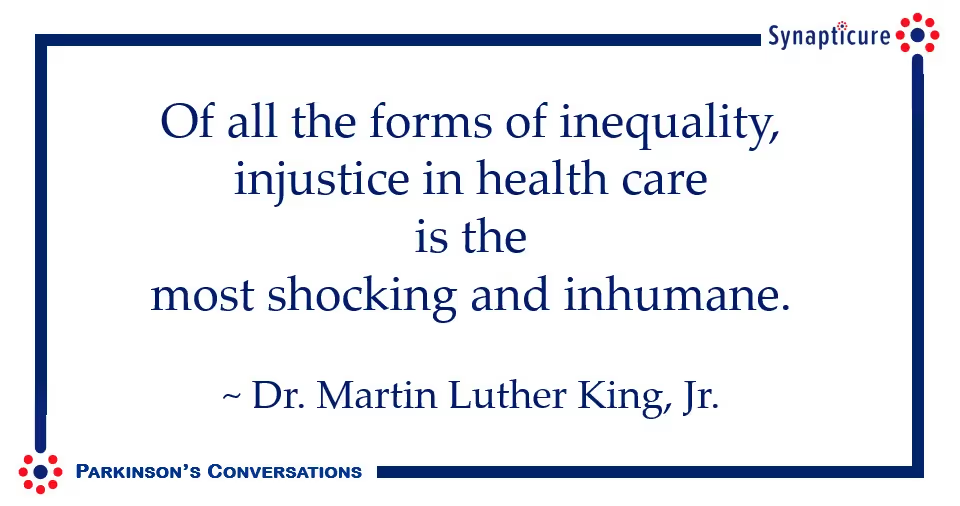Racial disparities in Parkinson’s disease are characterized by a complex array of historical and current factors that have resulted in profound racial and ethnic disparities in the diagnosis, treatment, and research participation of underrepresented minority (URM) communities, impacting not just health outcomes but also quality of life.
This week, I had the pleasure of hosting another Parkinson’s Conversation with my colleague, Dr. Chantale Branson, to talk about racial disparities in Parkinson’s Disease (PD) where we discussed:
- Historical events that have contributed to many people of color distrusting the medical community
- Delays in PD diagnoses among people of color
- How cultural barriers impact access to PD treatment & care
- Reasons or the lack of representation of underrepresented minority communities in medical training, specialty clinics, and clinical trials
- The BLAAC-PD study (Black and African American Connections to PD) study as part of the Global Parkinson’s Genetics Program (GP2), a resource of the Aligning Science Across Parkinson’s (ASAP) initiative that is executed by The Michael J. Fox Foundation for Parkinson’s Research (MJFF) to research whether any genetic factors are associated with people of color
- How environmental injustice may contribute to the prevalence among underrepresented minority communities
- How physician-patient concordance (same race) can help alleviate some disparities and/or allow some patients to feel more at ease
- How telehealth can help communities of color who don’t have access to a Center of Excellence or movement disorder specialist in their communities
Disparities in Diagnosis & Care
There are multiple disparities in diagnosis and care of people of color with PD. For example, when compared to White Americans, Black Americans with PD are:
- 50% less likely to be diagnosed with PD
- More likely to be diagnosed later in the disease progression
- 30% less likely to see a neurologist
- Less likely to receive care from movement disorder specialists
- Less likely to receive proper medications and dosage adjustment to address PD symptoms
- Less likely to participate in clinical trials
- Less likely to be prescribed physical or occupational therapy
- Less likely to receive referrals for advanced therapies like deep brain stimulation (DBS)
- Higher rates of dementia but due to disparities resulting in delay of diagnosis, may present at more advanced stages when diagnosed
- Lower quality of life
- Higher risk of death
Most published data indicate that there are 50% fewer Black Americans with PD. However, one prevalence study from 1985 calls those conclusions into question. Researchers went door-to-door in Copiah County, Mississippi—a community with approximately an equal number of Black and White Americans. Among the many interesting highlights of this study: (1) the rates of PD were similar regardless of race; and (2) twice as many African Americans had no prior PD diagnosis.
Research & Clinical Trials in Neurodegenerative Diseases
According to the recent Census data, there are 41 million black Americans (13% of US population) and 62 million Hispanic Americans (19% of US population). Yet, clinical trial participation among these URM communities is significantly less. According to the Association of Clinical Research Professionals, the average clinical trial has only 5% black and 1% Hispanic participants. Exemplifying this disparity in neurodegenerative diseases, according to a 2021 US FDA Drug Trials Snapshot report, an Alzheimer’s therapy was recently approved despite having only 3% Hispanic and 1% black trial participants. This disparity is even more egregious when you consider that Alzheimer’s and dementia disproportionately impact Hispanic (1.5x) and Black Americans (2x) more than white Americans.
Unfortunately, there is limited data on minority enrollment in Parkinson’s research. A study that is nearly 15 years old estimated that 8% of PD trial participants are non-white. But we can look to recently approved drug trials to test that estimate. Although Hispanic men over the age of 65 are the group with the highest incidence of PD, some drug sponsors don’t report if their trial enrolled Hispanic Americans. Of the PD data that is reported in the FDA’s Drug Trials Snapshot reports, one trial enrolled 85% white Americans, 14% Asian Americans and no black Americans. In another PD trial with 1000+ patients across 150+ sites in the US, EU, Asia & Latin America, only 5 participants were black. In another in the US enrolling 400+, five patients were black. And yet another enrolled 1100+ but only nine were black. These trials are not anomalies. We must change this statistic in future clinical trials in PD.One company leading the way is Genentech. They recently noted: “Health inequity is a crisis.” They are committed to addressing barriers blocking inclusive clinical trial participation and have developed initiatives to address these disparities. One big first step? They are committed to ensuring their trials include patient populations that mirror the patient populations in that disease. We applaud their leadership. You can search for possible clinical trials using MJFF’s Fox Trial Finder search engine.
Cultural Barriers
In a 2014 study at Penn, researchers found that people in URM communities may have different reasons for not seeking specialist PD care. We’ve long known that mistrust of the medical community persists in the African American community because of historical mistreatment in studies like the Tuskegee experiments from 1932-1972. However, this is only one factor. Many elderly Americans in URM communities perceived PD symptoms as a normal part of aging. In responding to this lack of awareness, Dr. Chantale Branson told US News & World Reports:
“The onus is on the medical community … It’s about getting the word out and having these conversations outside of the medical office, and talking with people within their community and trying to reach everyone.”
Environmental Injustice
Gary Miller, PhD, an expert on environmental factors in neurodegeneration, notes that “the exposome is the cumulative measure of environmental influences and the corresponding biological responses throughout the lifespan”. Many environmental toxicants have been shown to have disproportionate effects on Black, Indigenous and People of Color (BIPOC) and communities of low-income and wealth. Donley and colleagues note that these disparities are being perpetuated by numerous current laws and regulations including double standards regarding pesticide safety; inadequate protection for workers and children; failure to implement multiple executive orders, protections environmental justice executive orders; and inadequate training, support, monitoring and follow-up with vulnerable communities.
Resources
Many other organizations are stepping up to address these issues. One example is a partnership with Columbia University and PD Movers. They published an educational guide about Parkinson’s designed specifically for the Black and African American community. The storybook is entitled, “The PD Movers: We Keep Moving”. It’s a compilation of narratives from people and their caregivers “living and thriving with Parkinsons.” You can download a free copy to use and distribute in your communities.
How Telehealth can Help
A recent article in Brain and Life magazine spoke to how neurologists are working to address racial disparities in neurological care. A neurologist at the prestigious Massachusetts General Hospital acknowledged:
“For many of these patients it can be very challenging to get to the hospital or routine outpatient care…. The expansion of telehealth is also a way to expand access to neurological care in underserved communities.”
Telehealth allows clinicians to reach patients in the remotest of regions as long as there is internet connectivity. Even if patients themselves do not have access to the internet, partnerships between neurologists, such as those at Synapticure, and local clinics can provide patients access to expert neurological care in their own communities, surrounded by healthcare teams they already know and trust.
Summary
Racial disparities in access to care, delays in diagnosis, referrals to movement disorders specialists, and underrepresentation of BIPOC in research all contribute to inadequacies in the treatment of Black Americans with PD. More research into the causes of these disparities and concerted efforts to address them are desperately needed.
Speakers
Movement Disorder Specialists in Parkinson’s Disease
Chantale Branson, MD, is an Assistant Professor of Neurology in the Department of Internal Medicine at Morehouse School of Medicine in Atlanta, Georgia. She completed her residency training in Neurology and subspecialty training in Movement disorders and Sleep Medicine at Boston University Medical Center. She is the first movement disorders specialist at Morehouse and started the first in-person movement disorders clinic at Grady Memorial Hospital, a safety net hospital in Atlanta. Her research interests include understanding and improving health disparities among African Americans with Parkinson’s Disease (PD). Dr. Branson is a medical graduate of Boston University in Boston, Massachusetts.
Jaime Hatcher-Martin, MD, PhD is the Chief of the Movement Disorders Clinic at Synapticure. Prior to joining Synapticure, Dr. Martin practiced at Emory University and SOC Telemed. She started her own telemedicine clinic for patients with movement disorders in 2016. She is a Fellow of the American Academy of Neurology (AAN) where she has served various roles including co-chair of the Telemedicine Working Group and is the lead author on the AAN’s Telehealth Position Statement. She also serves on the Telemedicine Study Group for the International Parkinson and Movement Disorder Society. Dr. Martin earned her PhD studying the environmental toxins associated with Parkinson’s Disease.
To schedule an appointment with Dr. Jaime Martin to talk about your Parkinson’s care from the comfort of your home, contact Synapticure.












.png)


